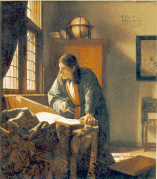 (Large)
(Large)
This painting is intimately linked with The Astronomer: they were recorded together in 1713, and sold together in 1729. These paintings reflect the blossoming of scientific enquiry in seventeenth century Europe.
 (Large)
(Large)
This painting is intimately linked with The Astronomer:
they were recorded together in 1713, and sold together in 1729.
These paintings reflect the blossoming of scientific enquiry in
seventeenth century Europe.
The geographer leans over an unrolled map or nautical chart, with a pair of dividers in this hand, deep in thought. He is dressed comfortably and informally, with his long hair pulled behind one ear. The terrestrial globe above him was made by Jodocus Hondius in 1600, and is a twin to the celestial globe in The Astronomer. It is, however, the same room as the twin painting, except that the painting The Finding of Moses has been replaced by a map of Europe, similar to a chart by William Blaeu from the early seventeenth century. There is more light in the geographer's world than the astronomer's: perhaps an indication that the former is less mysterious than the latter.
The painting is signed by Vermeer on the closet just above the geographer's head, and another inscription was added in the nineteenth century at the upper right of the painting.